

| Click to enlarge photos. | |
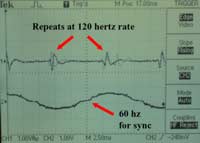 |
If your station is located in the real world, sooner or later you will be afflicted with the dread disease called power line noise. This can be so bad that you have very impaired reception - only very strong signals can be heard. This kind of plague sounds like buzzing or popping, snapping, etc. Power line noise is usually the direct result of arcing (or sparking) around or inside hardware on power distribution poles. It poisons lower frequencies ( < 30 MHz ) first, but can be so bad as to cripple VHF operations as well. Identification is the first step. Connect your speaker output to an oscilloscope, and synchronize on the line source, or the output of a low-voltage AC output "wall-wart". If you see the displayed pulses coincide with the line frequency, it's some form of power noise. The pulses will, for the most part, stay locked, and not drift horizontally. Note that sometimes, due to partial rectifcation, the pulse will repeat at a 60 Hz rate, conducting only on one polarity of the cycle. |
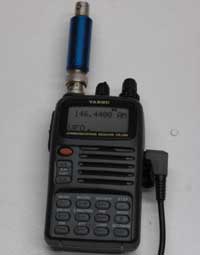 |
The problem may not be caused by the electric utility company's power poles - it could be inside your house, or your neighbor's. Aquarium heaters and electric doorbell transformers have been known to arc and generate noise. If the noise is more or less continuous, you should be able to localize it using a kit of three pieces: 1. A handheld VHF receiver that has a signal strength meter, and an amplitude modulation detection mode. Headphones can help. 2. 10 and 20 dB pads (AM receivers have automatic gain control which can mask signal strength indications unless you attenuate them close to the noise floor) 3. A five or six element Yagi (or log-periodic) antenna designed for the VHF frequency, with some kind of handle. The bigger, the better, so your neighbors will be more suspicious. Note that we use VHF (sometimes UHF) to localize it because portable antennas can be very directional at these frequencies - and this kind of "low-band" noise usually extends into the VHF / UHF spectrum. |
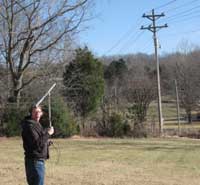 |
While trying to stay out from underneath the lines as much as possible, try to directionalize the source(s) of the noise. Tune around within the effective antenna bandwidth if it is not immediately apparent. A strong noise source will be audible for several hundred feet, while weaker ones may not be heard until you get closer to the poles. Always use as much attenuator pad as possible while still keeping it audible. When a source is located, get bearings on it from several angles. Investigate all possibilities within about 1000 feet of your station first, then extend it out to a 2000 foot radius. Most problems will be found within this range. Avoid sneaking through people's yards at night. |
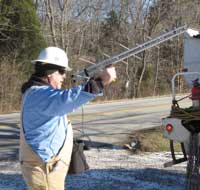 |
It is important that you do this initial homework before you blame the electric utility company, as sometimes the problem can be in your own house - turn breakers off one-by-one while listening to the noise to verify this is not the case. When you've located noise sources on the electric poles, then contact the utility folks. Although the utility company is responsible for fixing radio interference caused by their equipment, and some companies have had to be forced by the FCC into cooperation, most will try to correct the problems you report if you are courteous and helpful. Let them hear the noise, and show them your VHF locating process. |
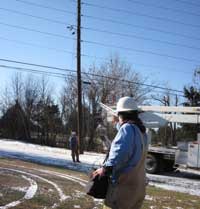 |
Most utility companies have a huge physical plant to maintain, and most are kept very busy just trying to keep reliable power supplied throughout their distribution network. So be patient, and work with them - don't be adversarial. They will likely begin by localizing to the pole using a VHF - UHF am receiver with a handheld log-periodic directional antenna that functions (unlike a Yagi) over a wide frequency range. If the noise is continuous, and not intermittent (some are) it will be found. In my case, many were found. The photo shows WRECC's Kenny Atkison directionalizing the buzzing source to a stacked three-phase pole. |
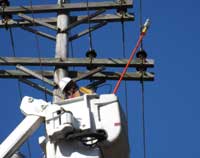 |
Once the suspicious poles are found, the actual arcing must be located amongst the pole hardware - this is usually done with an ultrasonic microphone type detector that converts 40 kHz energy into audible sound. Two types of these exist - one uses a parabolic reflector to hear it from the ground, while a popular unit is the Radar Engineers model 247, which mounts at the end of a "hotstick" It has an extension tube to help pinpoint the fault. |
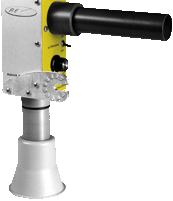 |
This same unit also has a desensitized RF-type receiver built into it for locating internal arcing that may not produce external ultrasonic noise. Some noise is intermittent - changing with moisture, temperature, or wind-induces mechanical vibration. The "snout' can also be used to tap on various hardware to initiate the intermittent burst. |
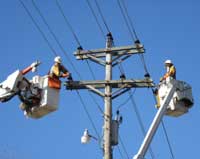 |
Remember, it's not cheap for the utility company to hunt for and fix all of these problems. In the picture at left, three of the top wire-wraps were heard to be generating noise, and were re-wrapped, curing the problem. Although arcing is always between two points of differing voltage potential, often, one side appears to be connected only to an insulator, the pole wood, or even air - in the intense electric fields in close proximity to the high voltage conductors, capacitive coupling can produce charges on pieces you would not expect.
|
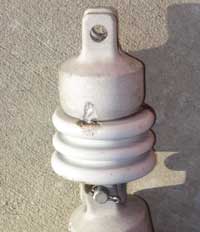 |
1-16-10 The good folks at Warren Rural Electric Cooperative Corporation have located and eliminated about six confirmed arcing problems. Two of them turned out to be lightning damaged insulators that were arcing internally. Many of these arcs will eventually deteriorate the material so much that a serious dielectric breakdown will cause a high current fault. Some more remain, as the noise is still present, albeit somewhat weaker - it can take time to clean up multiple sources, some of which are intermittent. I am fortunate to have a local utility company with such excellent customer service. |
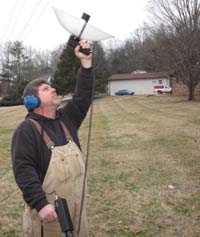 |
UPDATE 2-7-10 Kenny Atkison of Warren Rural Electric Cooperative brings out the heavy artillery using a parabolic ultrasonic microphone. Most (but not all) arcing generates ultrasonic noise as well as EMI, and this tool, made by Radar Engineers, was borrowed from TVA. Once the general area of the noise has been triangulated by directional antennas, the location of the fault on the pole can be verified and sometimes pinpointed with this tool. I am in the process of converting a surplus Direct TV antenna into a similar instrument, as the basic transducers made by kobitone are about $10. |
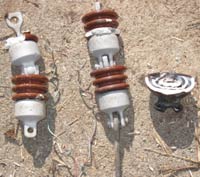 |
More bad antique insulators - these damaged by lightning |
Here's a close up view of a lightning-damaged insulator. As with all the photos, click to enlarge.
Score to date: At least 16+ arcing faults identified and fixed. Still searching for the intermittents, one of which results in 20 dB over S9, which pretty much kills all reception. Update 5/12: Two more intermittents solved. |
|
Common Power-Line Noise Sources (According to industry experts - Listed in order from most common to least common)
|
|
| Advice: do your best to cooperate with the power company. Only after you have given the power company several months to solve the problems, should you consider getting the FCC involved. Try again with the power company, reminding them that the FCC does in fact require interference caused by "unintentional radiators" to be resolved, and that you have done your best in helping them localize noisy poles. If the problems still go unresolved, only then contact the FCC via the ARRL liaison system, copying your politely written communications to the power company. | |
| The ARRL maintains a power line noise interference FAQ page - click here. | |
Back to W4NEQ main page |
|